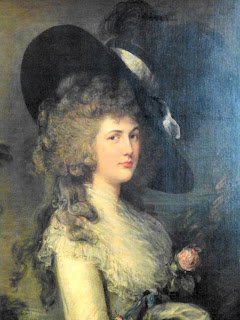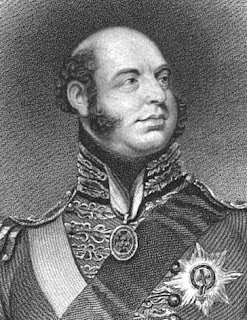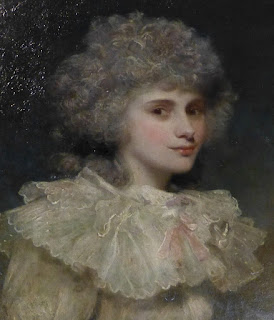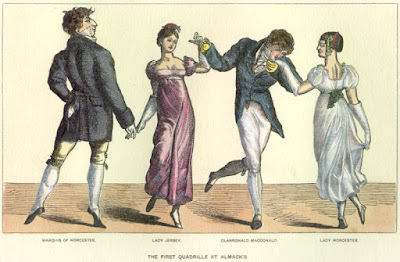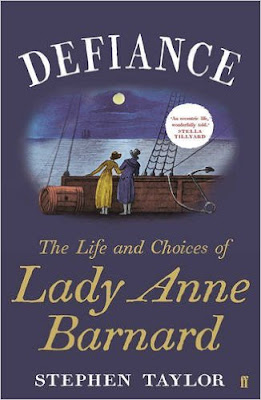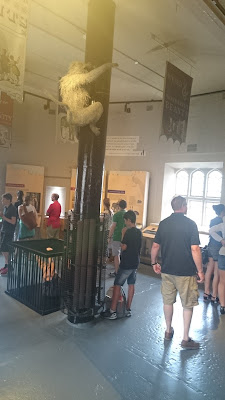 |
Portland Bill, Dorset (2016)
|
Overcoming adversity always makes for a good story, particularly when it involves a life-threatening situation. Charles Sturt, Member of Parliament for Bridport, Dorset, had such a tale to tell after sailing off Weymouth in 1800. Within a few days of his adventure, he wrote an account that was later published.
The story begins with
King George III, a frequent visitor to the seaside town, who often went aboard Royal Navy ships moored in the bay. On 20 September, the King, with Queen Charlotte and other members of the royal family, went aboard the frigate
Cambrian.
While the royals were being entertained by the Navy, Sturt sailed out into Weymouth Bay, where he encountered the cutter of Mr Weld, of
Lulworth Castle.
 |
| Weymouth, Dorsetshire by JMW Turner 1 |
Racing towards disaster
He decided to race Weld’s cutter, but was held back because his own vessel was towing a smaller boat. Sturt asked one of his crew to board this small boat and sail it back to Weymouth, but
...at this he hesitated and refused. I observed, ‘You my lads, have known me long enough to be satisfied I should not order you to do a thing I would not readily do myself, therefore, reef the sail, slip the mast, I will go myself.’2
Ordering his crew to continue the race with Weld, Sturt began the task of returning his boat to Weymouth. This required him to avoid the Shambles Bank, an area of submerged rocks to the south east of Portland Bill.
A very strong ebb tide carried me to the westward, and on for the Shambles, which I wished to avoid; put before the wind, but, being under a very low sail, could not stem the tide; dared not quit the helm to let the reefs out of the sail, for fear of broaching-to; the tide hauling me dead on the Shambles, where the sea was running tremendously high, and breaking horridly, no time to be lost.
The danger from the shallows of the Shambles is amplified by the nearby Portland Race, where land forces the tides to flow fast and dangerously, just off Portland Bill. Many ships have been wrecked and lives lost because of the Race and the Shambles.
 |
Portland Bill, Dorset (2016)
|
Time to take emergency action
Realising that he was in trouble, Sturt attempted to lighten his boat by throwing all his ballast overboard.
And convinced my boat could not exist many minutes, and nothing but the interposition of Providence save me, to divert my thoughts from the horrid idea of death, I began singing the sea song, ‘Cease rude Boreas’.
Written by playwright and poet George Alexander Stevens, ‘Cease rude Boreas’ was also known as ‘the storm song’ and seems to have been a popular choice among sailors facing serious wind and waves.
As I was singing the second verse, a dreadful sea, all foaming, took my boat on her larboard quarter, sheered a-weather my helm she lost her shorage-way broached-to, upset and overwhelmed, the sea rolling over and over; recovering from my alarm without the smallest hope of escaping, I swam to my boat, which was lying on her broadside: with difficulty I got into her and held her fast.
Having been thrown from his boat, and regaining it, Sturt decided he was overdressed for the occasion. He recorded that he “immediately pulled off my coat, waistcoat, shirt, and cravat; this I accomplished with much difficulty being wet”. Now he took in the gravity of his situation.
No sail near me; above fifteen miles from the nearest land; a dreadful hollow, broken sea running in every direction, and frequently overwhelming me, gave me no hopes of saving my life.
 |
| Waves crashing against the rocks on Portland |
Facing near certain death
Living near the Dorset coast, Sturt was an accomplished sailor, familiar with the hazards of sailing.
To surrender without a struggle, I considered weak; the thoughts of my wife and children, which at that period struck my mind very forcibly (I thought I saw them,) recollecting the difficulties I surmounted two years before, in saving some men from a wreck off my house, and knowing that they were saved from a situation as dreadful as my own by the assistance of Divine Providence this gave me resolution and fortitude to exert myself.
Sturt busied himself trying to organise his vessel as best he could, despite “being repeatedly washed off the boat”. While there were no other ships in sight, Sturt was not alone with the waves.
At this period, several gurnets (a large species of sea-gull,) hovered close to me, and were so bold as to come within two feet of my head. I suppose they anticipated a good meal on me; however, by hollowing pretty loud, I convinced them I was not yet dead; they took flight and I saw no more of them.
Having now spent three hours being soaked by the raging seas, Sturt was roused by the sight of two sails, but the ships were too distant for him to attract attention, so he didn’t bother. When a third, a brig, passed closer, he did all he could to get noticed.
 |
| The Pelican sailing off Weymouth Bay |
A chance of rescue
I succeeded; I saw her men go up the main shrouds, and the crew stand close together, but passed me without offering to lend me the smallest assistance; this indeed was enough for me to surrender up a life which was no longer supportable; such inhumanity excited in me the strongest emotions of anger; but alas! I had no means of redress; I gave up all hopes of being saved.
Now the wind began pushing Sturt’s boat towards the dangers of the Portland Race. Prospects of rescue failing, he began preparing his body for identification once he was dead.
I took a valuable diamond watch of my wife's out of my fob, tied it securely round the waistband of my trowsers, pulled them off, and tied them round the short of the boat; when I had done this, I made a running knot with the painter, intending to put it round me in my last moments, that my boat, as the wind was, would be driven near my house, or Bridport, and that my watch and seal would lead to a discovery of who I was: having done this, I became quite indifferent, death was no longer terrible; and as I saw no chance of being saved, I sat quietly in the boat, patiently waiting for the next wave to put an end to my suffering.
By his own account, Sturt’s patient waiting seems to have involved regularly being tipped out of and swimming back to his boat, for around an hour. By now, his boat seems to have capsized.
Running out of time
Then, at about half past four in the afternoon, he spotted a further eight sails. The first few to pass by were too far away to spot him.
I reserved my strength for the only two of the eight that had not passed me; a brig came by, I hailed her, lifted up my hands and fortunately I observed they saw me, for her men went up aloft to see what I was; they then tacked and stood toward me, but did not hoist a boat out; this alarmed me.
For whatever reason, the captains of two ships had decided to ignore the shouts and waving from a man in trouble on the seas.
There was only one more vessel to pass; it was nearly dark, a dismal sea and within two miles of Portland Race: if this passed me, all was over. I roused myself on this occasion, and hailed, her stood on the boat's bottom, was washed off, got on her again and was again washed off; however life was still desirable as long as I saw a chance of being saved.
On this occasion he was rewarded by the sight of a boat being lowered, and he realised rescue was imminent.
At that instant I was agitated, my firmness seemed to forsake me, for I burst into a flood of tears, and was seized with a violent retching from the quantity of salt water I had swallowed.
Rescue and rewards
It seems that with the assistance of his rescuers, Sturt was able to bring his boat alongside the ship Middleton, under Captain Rankin. Once aboard, Sturt was welcomed by Colonel Jackson of the 85th. At 8pm the Middleton sailed into Portland Roads, the sheltered waters that are now Portland Harbour.
 |
| Portland Harbour, Dorset |
Here he was reunited with his friends
Mr and Mrs Smith, from whom I received the kindest attention; they thought I was irrecoverably gone, so did their majesties, particularly as captain Ingram declared he saw my boat go down; however it was extremely reasonable to suppose I was lost, the sea running high and breaking in a most tremendous manner: he well knew on those shoals a boat could not long exist, and, on the whole, a most dreadful evening, it was reasonable to suppose I was no more.
Their majesties, with the dukes of Kent and Cumberland, lord and lady Cathcart, Parlet Cathcart: colonels Desborough and Wynyard, generals Goldsworthy Garth, &c, every soul, in short, in Weymouth, heartily congratulated me on my providential escape; the king and queen with their family, on the esplanade, expressed, in the kindest manner their very sincere happiness at my being saved.
Three days later, Sturt returned to the Middleton to thank his rescuers. He gave 10 guineas and a silver cup to Captain Rankin, 5 guineas each to four named crew members, and 20 to be distributed among the other sailors.
The captain and crew of the Earl of Abergavenny were less fortunate.
Rachel Knowles writes clean/Christian Regency era romance and historical non-fiction. She has been sharing her research on this blog since 2011. Rachel lives in the beautiful Georgian seaside town of Weymouth, Dorset, on the south coast of England, with her husband, Andrew, who wrote this post.
Find out more about Rachel's books and sign up for her newsletter here.
If you have enjoyed this blog and want to encourage me and help me to keep making my research freely available, please buy me a virtual cup of coffee by clicking the button below.
Notes
(1) From Picturesque Views on the Southern Coast of England (details below).
(2) All quotes from The Cabinet of Curiosities Vol 2 (1822) by Samuel Griswold Goodrich.
Sources used include:
Crotch, W, MacFarren, GA, and Wade, J Augustine, A Collection of National English Airs (1838)
Goodrich, Samuel Griswold, The Cabinet of Curiosities: Natural, Artificial and Historical Volume 2 (Hartford, 1822)
Turner, JMW, Picturesque Views on the southern coast of England, from drawings made principally by JMW Turner and engraved by WB Cooke and others (1826)
